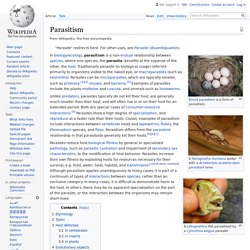

Mistletoe. Mistletoe in the genus Viscum[edit] The name mistletoe was originally applied to Viscum album (European mistletoe, of the family Santalaceae in the order Santalales), the only species native in Great Britain and much of Europe.

European mistletoe is readily recognized by its smooth-edged oval evergreen leaves borne in pairs along the woody stem, and waxy white berries in dense clusters of two to six. It is a poisonous plant that causes acute gastrointestinal problems including stomach pain and diarrhea along with low pulse.[1] The genus Viscum is not native to North America, but Viscum album has been introduced to California.[2] Parasitism. Unlike predators, parasites typically do not kill their host, are generally much smaller than their host, and will often live in or on their host for an extended period.

Both are special cases of consumer-resource interactions.[4] Parasites show a high degree of specialization, and reproduce at a faster rate than their hosts. Classic examples of parasitism include interactions between vertebrate hosts and tapeworms, flukes, the Plasmodium species, and fleas. Parasitism differs from the parasitoid relationship in that parasitoids generally kill their hosts.[5][6][7] Etymology[edit] Parasitic architecture. Introduction - parasitic architecture. 1.1. website introduction "parasites intrude and inhabit.

" Benjamin, A., 2002. [online] Parasitism in Architecture.